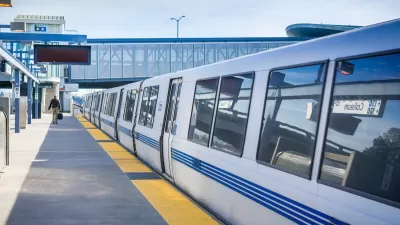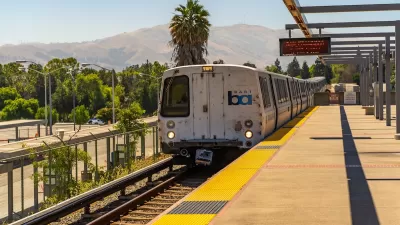Sam Raby argues that BART’s pay by distance fair structure exacerbates transit inequities.

San Francisco BART riders pay more if they go farther, but in a city as expensive as San Francisco many of those who ride the furthest have the least to spend. Sam Raby spoke to a local handyman, Mark Rogers Nelson, who would sometimes find himself priced out of transit. "Nelson was homeless up until recently, and he remarks that he often got 'stuck on one side' of the Bay during this period because of BART’s high fares," writes Raby. People with lower incomes are more likely to be found further from the center of San Francisco and may have to take longer commutes as a result. "And while the median income of the Bay Area Metro is around $97,000, more than 50 percent of workers in the Bay make less than $50,000 a year, according to the most recent census data," according to Raby.
BART leadership points out that pricing for service means riders pay for what they use. Flat fares mean riders taking short trips subsidize the service for everyone else. "While the New York MTA, the Chicago 'L,' and the Los Angeles Metro charge a flat fare to ride anywhere in their network, BART is one of three rapid-transit systems that charge passengers by distance. (Washington, D.C.’s WMATA and Philadelphia’s PATCO are the other two)" according to Raby. But systems like the CTA in Chicago do not cover the same distances as the BART, so they face a different set of challenges.
A related issue is the number of transit operators in the Bay Area. While area residents can pay for many different services with Clipper Fare cards, those services set their own fares and have their own policies. "In an effort to ease the burden on low-income riders, the Metropolitan Transportation Commission (MTC), the transportation planning and financing agency for the entire Bay Area, is pushing for region-wide system reforms," writes Raby.
FULL STORY: The inequity of pay-by-distance transit in the Bay Area

Planetizen Federal Action Tracker
A weekly monitor of how Trump’s orders and actions are impacting planners and planning in America.

San Francisco's School District Spent $105M To Build Affordable Housing for Teachers — And That's Just the Beginning
SFUSD joins a growing list of school districts using their land holdings to address housing affordability challenges faced by their own employees.

The Tiny, Adorable $7,000 Car Turning Japan Onto EVs
The single seat Mibot charges from a regular plug as quickly as an iPad, and is about half the price of an average EV.

With Protected Lanes, 460% More People Commute by Bike
For those needing more ammo, more data proving what we already knew is here.

In More Metros Than You’d Think, Suburbs are Now More Expensive Than the City
If you're moving to the burbs to save on square footage, data shows you should think again.

The States Losing Rural Delivery Rooms at an Alarming Pace
In some states, as few as 9% of rural hospitals still deliver babies. As a result, rising pre-term births, no adequate pre-term care and "harrowing" close calls are a growing reality.
Urban Design for Planners 1: Software Tools
This six-course series explores essential urban design concepts using open source software and equips planners with the tools they need to participate fully in the urban design process.
Planning for Universal Design
Learn the tools for implementing Universal Design in planning regulations.
Smith Gee Studio
City of Charlotte
City of Camden Redevelopment Agency
City of Astoria
Transportation Research & Education Center (TREC) at Portland State University
US High Speed Rail Association
City of Camden Redevelopment Agency
Municipality of Princeton (NJ)





























